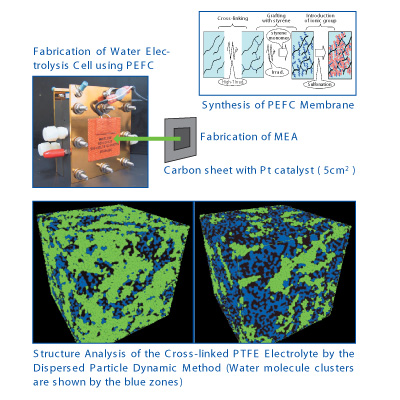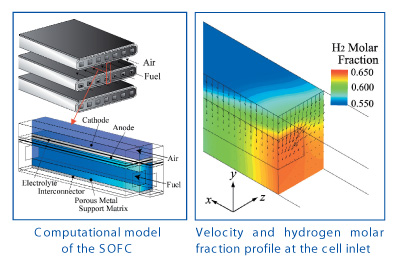 |
 |
|
|||||||||||||||||||||||||
|
| High-efficiency fuel cell power generation system ―From development of a new electrolytic film to simulation of heat and fluid flow inside a cell― |
| Synthesis of Polymer Electrolyte Membrane for PEFC |
 Takayuki Terai, Professor Takayuki Terai, ProfessorDepartment of Quantum Engineering and System Science Hydrogen energy system is expected as an secondary energy system, and 吐uel cell・is a key technology. We are investigating the improvement of PEFC (Polymer Electrolyte Fuel Cell) , which has some advantages including low operating temperature. In particular, we are developing a new polymer electrolyte membrane, and successfully synthesized a new polymer membrane from cross-linked poly-tetra-fluoroethylene (PTFE) with radiation grafting reaction. It has some advantages such as higher strength, lower swelling for water or methanol, higher proton conductivity and lower fabrication cost than the currently used Nafion membrane. In addition, we simulated the molecular structure of the membrane using the dispersed particle dynamic method and found the the formation of water molecule clusters in the membrane. |
 |
| Numerical Simulation of Thermochemical Reaction inside a Fuel Cell |
 Nobuhide Kasagi, Professor Nobuhide Kasagi, ProfessorDepartment of Mechanical Engineering Fuel cell is one of the most promising energy conversion processes. Especially, the solid oxide fuel cell (SOFC) is expected to achieve very high efficiency for a wide power output range, and its prospective application extends from large power plants to small-scale distributed generation systems. The objective of this work is to develop high performance SOFC by managing temperature distribution and promoting mass transfer in a cell. The heat and mass transfer as well as electrochemical reactions in the cell are solved simultaneously to predict the performance of the cell. We also try to propose new cell configurations and operating methods to achieve even higher efficiency with this cell and system simulator. |
 |
Page top |